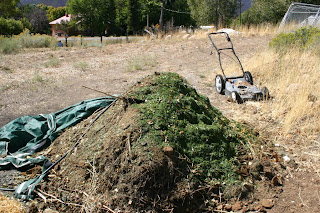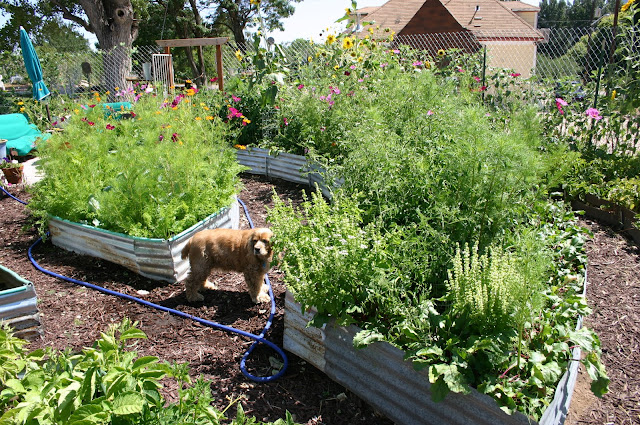Hi Garden and Cooking Fans! This is my first post on this blog and I thought I'd introduce you to my vegetable garden. I dreamt of this garden for over a decade, knowing exactly where I wanted to build it but knowing that fencing, water, and other issues had to be installed before I could begin the actual garden. I read books and magazines, watched how others built theirs and schemed and sketched. Finally my husband and I were ready and we had a friend clear the area with a little bobcat tractor and make a semi level area to get started. A friend and I had trenched a waterline a few years earlier and I used that as the center point of my round garden.
Here's a slideshow of the garden it's first year. I'll explain the process in a bit, but I hope you enjoy seeing it go from dirt to green in a quickly gratifying slideshow. The actual process is a buttload of work, but has paid off considerably.
http://www.slide.com/r/oCZFn0zPxD8W6K8mCQY_VCrLWmxpBgI6?previous_view=mscd_embedded_url&view=original
The Lasagna Garden
Like dieting, there's only a few simple but absolutely true and hard rules that go into gardening. Diet and exercise, portion control, and more diet and exercise pretty much sum up all the volumes of books, magazine articles and guides to losing and controlling ones weight. With gardening it can be summed up in three terms. Soil, Sun, Water. Selecting the site that provides the best of all three is the most important aspect to a successful garden and for many people it's a challenge because of shade, of access to the home or proximity of fences and other structural considerations. I have an acre so had plenty of space, but only a small section that had good soil and the potential for full sun. The little pioneer home was built on the absolute best soil on the property and I wasn't going to tear down the house to put in a vegetable garden, so I chose the area about 50' behind the house for my site.
We cleared it from brush, grass, rocks and debris with a bobcat and put in a water line directly in the center of the 50' diameter circle. I would have made it bigger but I was going for the most effective coverage of the Rainbird sprinkler that we anticipated for the center. Also that's where the best soil was without cutting into the really rocky clay covered hillsides.
I'd drawn my plan numerous times trying to calculate the least amount of wasted space and finally arrived at concentric circles with 3' wide walkways between for future wheelchair access. This isn't always possible or practical and more narrow walkways may work better for some. I was going for a plan that made turning the wheelbarrow through the paths easiest as well as provided potential wheelchair accessibility. If I were to do it over again I'd probably go with nice easy straight lines. Circles are pretty, but not very easy to build since most materials come in straight products.

One big mistake I made in addition to trying to make the tin go in a circle was that I made my bins about a foot too wide. I'm short and even while bending over it's hard to reach the middle of the bins to harvest vegetables, pull weeds, or turn the soil. I made the bins 4' wide and they would have been better at no more than 3'. Turning the wheelbarrow in some of the corner and connecting areas has proven a little challenging as well. Part of that is because the bins are almost 2' tall and the legs and front of the wheelbarrow hit them as I round the corners. I like the taller bins for comfort of use though so it's a worthwhile compromise.
After the bins are laid out BABB and I cut stakes from electrical conduit. I wanted stakes that wouldn't rot and were thin enough to work in the potentially rocky soil below the garden spot. Wooden stakes split and rot and seemed to be harder to get straight, especially when I'd hit a rock. They were expensive too compared to how many I could cut from one ten foot run of EMT. We cut the stakes at 30" and got four stakes per stick of EMT. I pounded them in about 6" deep at each bend in the corrugated tin. If I were to make straight beds I think I'd need fewer stakes. We did bend the tin at 90 degree angles for the corners to avoid sharp edges but with some creative re-purposing I think wooden corners with a channel or some sort of trough to hold the tin might work better.
We started off laying out the areas with newspaper that we sprayed down with water to hold it in place and then piling raw debris and loose compost on top but I think it would have been better to build the bins first and then add the newspaper and compost. I was just excited to get started and BABB was not enjoying the tin bending as much as he should have (silly man, why doesn't he like pounding tin while on his knees in the dirt?).
Once we had the bins laid out and the first layers of compost and debris distributed I started digging the dirt in the walkways and piling it on top of the debris in the bins. Topsoil is very fragile and the micro-biotic layers and relationships between critters, nutrients, etc. is very important to the success of the garden. From all that I'd read it is very important that topsoil be undisturbed as much as possible for the health of the plants. Having loose and nutrient rich material under the topsoil helps the roots of the plants to grow and absorb the moisture they need so it made sense to put the good soil from the walkways on top of the lasagna layered compost. Turns out all the books were correct on this because within my first few months I was seeing really healthy plants and plenty of produce.
I collected a bunch of old hose from my mother and a few other places and cut it lengthwise then drilled holes and wired the hose to the top of the tin edge to keep it from being too sharp and cutting someone (me) in case of tripping or falling in the garden. It's also helped keep the edges from being bent and broken or becoming jagged. Tin is very sharp and can be deadly if you fell in the wrong spot. It was the least expensive material and would last longer than wood and I had plenty salvaged from an old shed so that was why I chose tin for my bin walls. Timbers and several other types of walls are great too but I went with what I had and could afford. So far it's worked out great. in straight 8' x 3' runs it would be even easier and faster to build. We cut the tin sheets in half the long way on a table saw and put the sharpest edge toward the soil.
Once I'd piled the walkway soil on top of the compost debris I added a little dry manure and some sand and mixed it all in to create a loamy loose soil. In the places where I didn't get it really level or it sunk in after the compost collapsed the seeds tended to drift down and water pooled up. I just add a little soil and compost to those areas and rake it smooth again. Getting the garden as level as possible helps keep the watering even and seeds in place. It's a work in progress and gravity seems to dictate a lot of the needs of the garden. Gravity and mother nature always win so I try to cater my efforts to those factors.
After we finished the bins we laid down flattened cardboard boxes and thick layers of newspaper in the walkways and then dumped loads of bark mulch over them and raked it fairly level. If you don't have bark mulch then grass clippings might work but they get pretty moldy and pack down quickly when they get wet. This year the bark had broken down enough that the walkways needed another layer so I just piled straw over them than let it settle in. As it decomposes I'll fork it into the bins and replace the old stuff with fresher fluffier mulch. It's worked fairly well to keep the weeds out but anywhere there's moisture and soil you're going to get something growing.
The fencing, watering, and other issues are for another post. Hopefully this helps you see that a lasagna garden and raised beds can be achievable and worthwhile. There's many ways to arrive at that end and lots of fun in the process. Don't be afraid to use what you can scrounge around your own area and improvise if you don't have the perfect products. In another life we'll all have the money, time, and energy to build perfect bins with store bought products, but in this life we make do with what we have. Hope you enjoyed this process.














